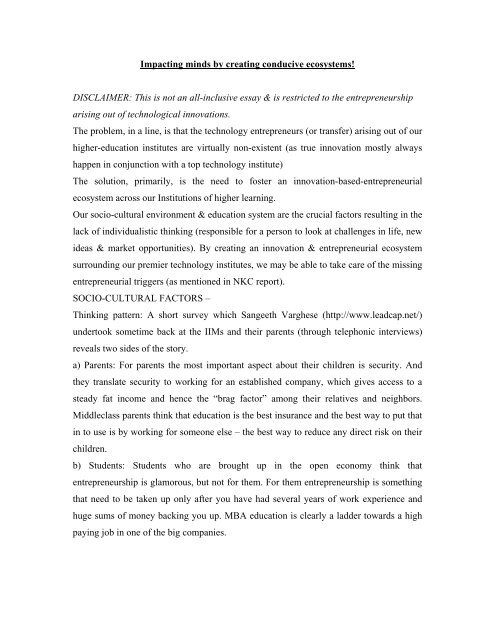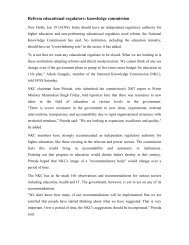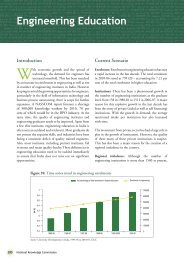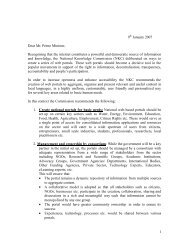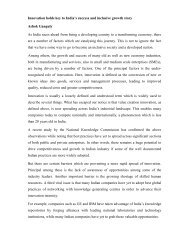Vaibhav Garg - National Knowledge Commission
Vaibhav Garg - National Knowledge Commission
Vaibhav Garg - National Knowledge Commission
- No tags were found...
You also want an ePaper? Increase the reach of your titles
YUMPU automatically turns print PDFs into web optimized ePapers that Google loves.
Impacting minds by creating conducive ecosystems!DISCLAIMER: This is not an all-inclusive essay & is restricted to the entrepreneurshiparising out of technological innovations.The problem, in a line, is that the technology entrepreneurs (or transfer) arising out of ourhigher-education institutes are virtually non-existent (as true innovation mostly alwayshappen in conjunction with a top technology institute)The solution, primarily, is the need to foster an innovation-based-entrepreneurialecosystem across our Institutions of higher learning.Our socio-cultural environment & education system are the crucial factors resulting in thelack of individualistic thinking (responsible for a person to look at challenges in life, newideas & market opportunities). By creating an innovation & entrepreneurial ecosystemsurrounding our premier technology institutes, we may be able to take care of the missingentrepreneurial triggers (as mentioned in NKC report).SOCIO-CULTURAL FACTORS –Thinking pattern: A short survey which Sangeeth Varghese (http://www.leadcap.net/)undertook sometime back at the IIMs and their parents (through telephonic interviews)reveals two sides of the story.a) Parents: For parents the most important aspect about their children is security. Andthey translate security to working for an established company, which gives access to asteady fat income and hence the “brag factor” among their relatives and neighbors.Middleclass parents think that education is the best insurance and the best way to put thatin to use is by working for someone else – the best way to reduce any direct risk on theirchildren.b) Students: Students who are brought up in the open economy think thatentrepreneurship is glamorous, but not for them. For them entrepreneurship is somethingthat need to be taken up only after you have had several years of work experience andhuge sums of money backing you up. MBA education is clearly a ladder towards a highpaying job in one of the big companies.
EDUCATION SYSTEM –Here, we look at what needs to be done at an undergraduate level. In the current scenario,students are motivated to work only for things that will help build their CV for a highsalaried job, MBA, etc. It is difficult to break this monotony and see people turning upfor lectures, workshops & events purely for the love of learning. This is also because, tomost of them, the present form of learning appears to be non-exciting, uninviting & farfrom reality. Moreover, the high-paying jobs happen to be in the non-tech sector.The proposed solutions aim to draw undergraduates into research, innovation &entrepreneurial settings and are relevant at the University/Institute level (MICRO), but,POLICIES at the highest level (MACRO) are needed to drive us in the direction required.EFFECTIVE COURSES & TEACHINGWhy? - Students unaware of empowerment that engineering/technological education canbring about (Reason why only 16% graduates became entrepreneurs in the field theystudied)=> Courses which facilitate discussion on problems that need solutions,components/designs to address new needs, techniques/approach to bring improvements inexisting state of things might be useful to get the students thinking. Basically our coursesmust try to get them in looking at inventing as a conscious step.Inspirational teaching & motivating are essential to excite the students about a subject,but, neither does it come naturally to many nor does the qualification required to be afaculty (in our institutes) provide the exposure to make teaching interesting. So, it’s verycritical to organize short workshops for faculty members on teaching techniques &understanding student psychology.INDUSTRY PROJECTSWhy? - Most students are unable to see connection between academics & real world=> The short-term Industry projects (not involving significant amount of basic research)may be carried out by undergraduate students (on suitable stipends) under the guidance offaculty members. Stipends may be a motivation, but this will in turn instill the confidenceof carrying out the laboratory testing/analysis.Also, involving students at discussion level in long-term projects will help them look atthe bigger picture & they, in turn, will bring in fresh ideas to the table.
CONCERTED PRACTICAL LEARNINGWhy? - The laboratory work does not involve 'experimenting' in the true spirit which mayrequire progress at own pace, through independent methodology without 'fear' or 'success'in the 'experiment'=> There could be project mode work in place of some of the conventional laboratorycourses. Such projects could be wholesome in nature starting from ideas that are easy toabsorb, improving every semester till they get implemented in the form of a prototype oran exhibit (which can be showcased to other students/innovators in the region). Suchprojects may be carried out in teams with a Faculty member as guide & a senior studentas mentor. Wherever possible the project may be decided with help of the industry and anindustrial mentor may be included to provide guidance to the students.Further as part of such laboratory, the students must be encouraged to disassemble &assemble simple/discarded gadgets, devices, etc. which help them appreciate the focused& patient efforts needed in development of new products.The above laboratories can also be directed towards supporting grass-roots innovations inthe country through scientific/technological inputs as exemplified by the <strong>National</strong>Innovation Foundation. Technology students can play a vital role in simplifying day today lives of people, particularly those living/working under poverty or harsh conditions.ALL IN ALL AN ATMOSPHERE CONSCIOUSLY NEEDS TO BE CREATED INENGINEERING/TECHNOLOGY INSTITUTES WHERE LEARNING DOESN’THAPPEN JUST BY ATTENDING COURSES & PASSING EXAMS, BUT INSTEADTHERE IS A FLUID ATMOSPHERE WHEREIN STUDENTS GEL WITH THEFACULTY TO WORK ON INNOVATIVE PRODUCTS.TOURS TO ENTREPRENEURIAL HUBS –http://nusea.org/. It provides opportunities for NUS students to work in high-tech startupsin Silicon Valley (and other entrepreneurial hubs) for a year, along with attendingentrepreneurial courses at Stanford. Such tours will be helpful to Indian students too &can be undertaken easily with the support of our alumni.Here, Silicon Valley is merely a path to help people broaden their horizons, so that theyknow how others apply their technical knowledge to create beautifully useful products.This would also be helpful to expose them to a not-so-common-here line of thought
wherein people look at their life, careers & technology in a different light. This wouldessentially bring out their innovative aspect & as a consequence MAY lead them to betechnopreneurs.CREATING STARTUP HUBS-At our Universities (inc. IITs), there are rarely any opportunities to interact with peoplewho have been involved in innovations, inventions, development of products that haveimpacted human lives, be it design of drugs or household items. Innovation anddevelopment process has its own charm, excitement, ups & downs, etc. which is essentialto get it across to the student.But, plain talks & lectures just would not suffice. Talks & lectures can be helpful ingenerating the spark needed, but sustaining it, seems only possible if students get tointeract with some of these people on a regular basis.So, to initiate the process we need to attract such people who’ll act as “SEED” & willmove with their innovations to grow their startups in & outside our technology institutes(despite lack of numerous infrastructural issues). We need these SEED people to infectthe young minds towards technological innovation, to give them hands-on opportunities,to kick-start their thought process, to push them to dream & DREAM BIG, to incite themto change the world through breakthrough technologies.People who work for startups generally start their own & those who get rich from startupsfund new ones. But, it’ll take years & we’ll have to nurture the initial ones till a criticalmass happen & the place organically grows into a start hub.To bring the SEED here, government may need to create special zones aroundUniversities where there would be every ease of starting a business based ontechnological innovation (though not TECHNOLOGY PARKS where there are only bigcompanies).--Today most educated Indian youth aspire to be IT entrepreneurs. We’ll need activeGovernment involvement to dictate policies in other upcoming technologies so as to drivepeople to take these seriously.
Is IT being a low capital intensive industry a reason people’s thoughts naturally takerecourse to it? Probably. So, for audacious ideas to germinate, we need to get the ease &money factor out of our youth’s psyches.Information dissemination is important & we need to show Examples to our educatedyouth, of young Indian technopreneurs who identified market opportunities & tappedthem to advantage in diverse fields.Innovation opportunities going forward will be at the cusps of different disciplines, but,in our country cross-domain research is virtually non-existent. For such research tohappen, we’ll need to fill the gap of missing interaction between various departments atan Institute level. Once that happens, probably then we can think of issues related totaking such innovations to the market.The government, besides directly promoting research, can take indirect steps. This canhappen if the risks & rewards are shared by various stakeholders, with each having stakesat different stages of a large-scale innovation project. Example - Policies which push thecostly primary technological product providing industries (A) to take stake in theupcoming innovative startup which uses the products of A to build secondary innovativeproducts.So, in this way if we can make as many stakeholders as possible in developing theentrepreneurial ecosystem, it will be conducive for innovation. {And the government maystep in & out, when required, to facilitate the process}--Though there is no dearth of industry consultancy projects at institutions like the IITs,but, the long-term projects necessary to bring about product innovations are not toomany.A central body which guides & directs our technology institutes towards long-term,society-useful research & innovation may be helpful.Technology Transfer, too, is missing in our institutes. Most faculty members, who areable to successfully commercialize their research, do so by going out of the way to helpcreate a business around their research. The incentive schemes for promotion andevaluation does not take their contribution in a technology transfer project into account.This creates a strong disincentive for working on a prototype around a core innovation.
Hence, incentive schemes for faculty and research staff in our technology institutes needto be reworked in such a way that their efforts towards technology transfer can berewarded at par with generation of core research as an output. This would present achoice in front of the researcher to take up prototyping and commercialization oftechnology rather than single-minded focus of producing quality research. Such goalcongruence can be expected to lead significantly higher pace of technology transfer in theinstitutes.We also have a bigger challenge of exciting more quality students to take up PhD afterthey graduate & then retaining them in the research institutions in our country. There isalso generally a tendency of insecurity in the existing researchers in the country abouttheir future employment.Also, setting up of Technology Licensing Office (to protect), Technology Transfer Group(to market) & having Industry Day (to showcase) in our technology institutes might beuseful in commercializing the existing innovations & stimulating the academicenvironment towards further innovation.Therefore, COHERENT POLICY MEASURES at the <strong>National</strong> & University level areessential to kick-start the innovation & entrepreneurial process.Everything will organically fall in place if we can instill, in our talented students, thefollowing line of thought –“Twenty years from now you’ll be more disappointed by the things you didn’t do than bythe ones you did; so throw off the bowlines; sail away from the safe harbor; catch thetrade winds in your sails; explore, dream, discover.” –Mark Twain“Do you want to spend the rest of your life selling sugared water or do you want a chanceto change the world?” –Steve Jobs--- Written by <strong>Vaibhav</strong> <strong>Garg</strong> (Final Year Undergraduate, IIT Bombay). Previously coregroup member at the Entrepreneurship Cell & currently the founding member ofTechnology Transfer Group, student bodies at IIT Bombay.


